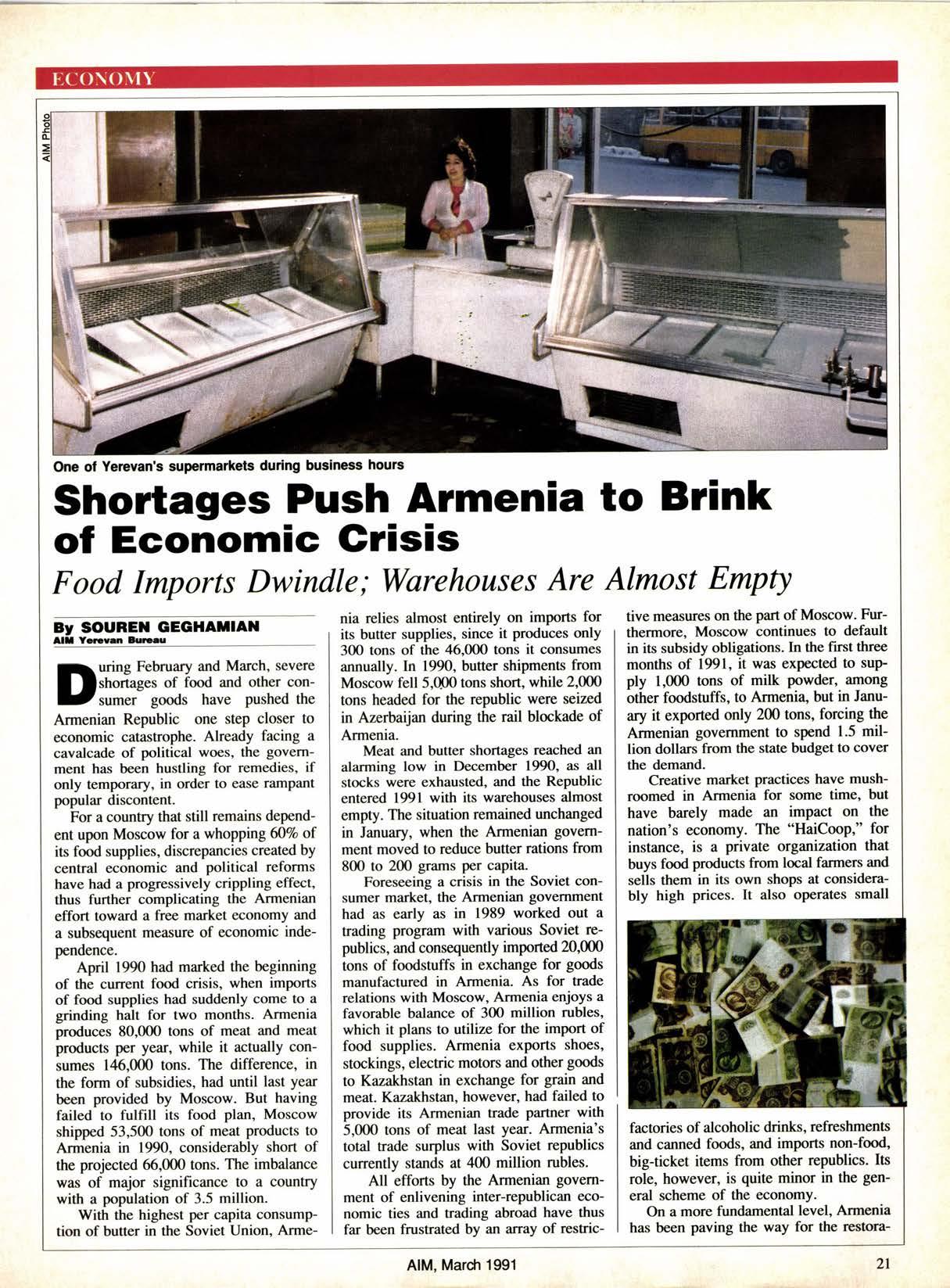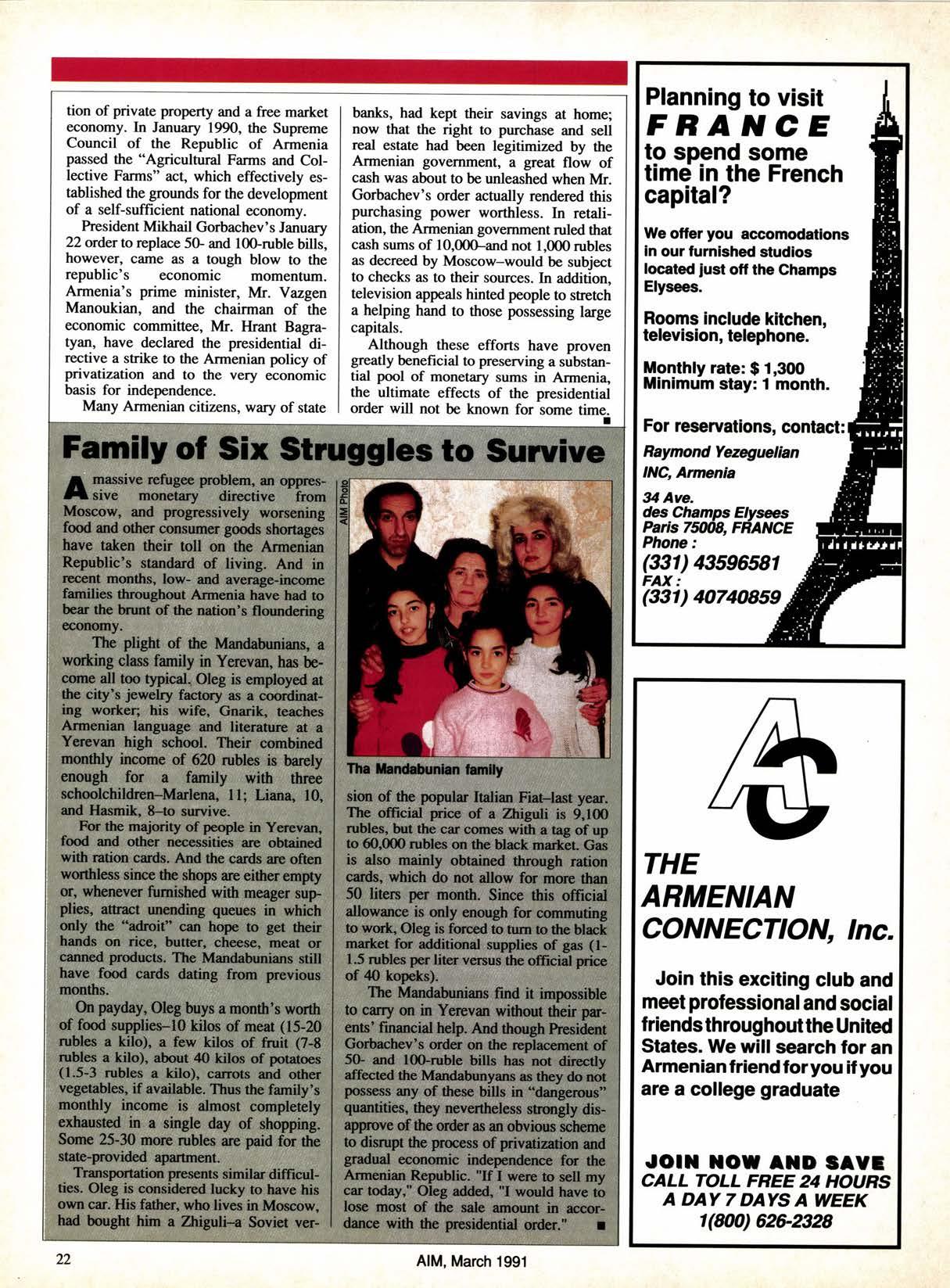
7 minute read
Shortages Push Armenia to Brink of Economic Grisis
Food Imports Dwindle; Warehouses Are Almost Empty
By SOUBEII GEGHATIAI AlIYoYfl fnu
Advertisement
uring February and March, severe shortages of food and other consumer goods have pushed the Armenian Republic one step closer to economic catastrophe. Already facing a cavalcade of political woes, the government has been hustling for remedies, if only temporary, in order to ease rampant popular discontent.
For a country that still remains dependent upon Moscow for a whopping60Vo of is food supplies, discrepancies created by central economic and political reforms have had a progressively crippling effect, thus further complicating the Armenian effort toward a free market economy and a subsequent measure of economic independence.
April 1990 had marked the beginning of the current food crisis, when imports of food supplies had suddenly come to a grinding halt for two months. Armenia produces 80,000 tons of meat and meat products per year, while it actually consumes 146,0(X) tons. The difference, in the form of subsidies, had until last year been provided by Moscow. But having failed to fulfill its food plan, Moscow shipped 53,500 tons of meat products to Armenia in 1990, considerably short of the projected 66,000 tons. The imbalance was of major significance to a coun[ry with a population of 3.5 million.
With the highest per capita consumption of butter in the Soviet Union, Arme- nia relies almost entirely on imports for its butter supplies, since it produces only 3(X) tons of the 46,fi[ tons it consumes annually. In 1990, butter shipments from Moscow fell 5,Q00 tons short, while 2,000 tons headed for the republic were seized in Azerbaijan during the rail blockade of Armenia.
Meat and butter shortages reached an alarming low in December 199O, as all stocks were exhausted, and the Republic entered l99l with its warehouses almost empty. The situation rcmained unchanged in January, when the Armenian govemment moved to reduce butter rations from 800 to 200 grams per capita.
Foreseeing a crisis in the Soviet consumer market, the Armenian govemment had as early as in 1989 worked out a rading program with various Soviet republics, and consequently imported 20,m0 tons of foodstuffs in exchange for goods manufactured in Armenia. As for trade relations with Moscow, Armenia enjoys a favorable balance of 3fi) million rubles, which it plans to utilize for the import of food supplies. Armenia exports shoes, stockings, electric motors and other goods to Kazakhstan in exchange for grain and meat. Kazakhstan, however, had failed to provide its Armenian trade partner with 5,0(X) tons of meat last year. Armenia's total trade surplus with Soviet republics currently stands at 400 million rubles.
All efforts by the Armenian govemment of enlivening inter-republican economic ties and tradhg abroad have thus far been frustrated by an array of restric- tive measures on the part of Moscow. Furthermore, Moscow continues to default in its subsidy obligations. tn the first three months of l9l, it was expected to suP ply 1,000 tons of milk powder, among other foodstuffs, to Armenia, but in January it exported only 200 tons, forcing the Armenian govemment to spend 1.5 million dollars from the state budget to cover the demand.
Creative market practices have mushroomed in Armenia for some time, but have barely made an imPact on the nation's economy. The "HaiCoop," for instance, is a private organization that buys food products from local farmen and sells them in its own shops at considerably high prices. It also operates small factories of alcoholic drinks, refreshments and canned foods, and imports non-food, big-ticket items from other republics. Its role, however, is quite minor in the general scheme of the economy.
On a morc fundamental level, Anne,lria has been paving the way for the restom- tion o1'privatc propcrty and a liee markel economy. In Junuary 1990, thc Supremc Council of' thc Republic of Armenia passed thc "Agricultural Farms and Collectivc Farms" act, which el'f'cctively cstablishcd thc grounds for the devclopment ol a scll-sufl-icicnt national cconomy.
Presiclcnt Mikhail Gorbachev's January 22 ordcr to rcplace 50- and l(Xlrublc bills, howevcr, came as a tough blow to the republic's economic momentum. Arrncnia's prime minister, Mr. Vazgen Manoukian, and the chairman of the economic committce, Mr. Hrant Bagratyan, have declarcd the prcsidential dircctive a strike to thc Arrnenian policy ofprir alization and to lhr vcry economit. basis fbr independcnce.
Many Armenian cilizens, wary ol statc banks. hacl kcpt (heir ,or,n*, lt home: now that thc right to purchase and sell real estatc had been legitimized by the Armcnian government, a great llow of cash was about to be unlcashed when Mr. Gorbachev's order actually rendcred this purchasing power worthless. In retaliation. the Armenian govemment ruled that cash sums of lO,0O0-and not I ,000 rubles as dccreed by Moscow-would be subject to chccks as to their sources. In addition, television appeals hintcd people to stretch a hclping hand to those possessing large capitals.
Although these cfforts have proven grcatly beneficial to prcscrving a substan tial pool of monctary sums in Armcnia, the ultimatc ef'fccts ol' the presidential ordcr will not ha known for some time.
Family of Six Struggles to Suruive
1 massive relugce problem, an oppres-
A ,,u. -,-rneiory orrecrrve trom Moscow, and progressively worsening food and other consumer goods shortages have taken their toll on the Armenian Republic's standard of living. And in recent months, low- and average-income families throughout Armenia have had to bear the brunt of the nation's lloundering economy.
The plight of the Mandabunians, a working class family in Yerevan, has become all too typical. Oleg is employed at the city's jewelry factory as a coordinating worker; his wife. Gnarik, teaches Armenian language and literature at a Yerevan high school. Their combined monthly income of 620 rubles is barely enough for a family with three schoolchildren-Marlena, 11; Liana, 10, and Hasmik, 8*to survive.
For the majority o[ people in Yerevan, food and other necessities are obtained with ration cards. And the cards are often worthless since the shops are either empty or, whenever fumished with meager supplies, attract unending queues in which only the "adroit" can hope to get their hands on rice, butter, cheese, meat or canned products. The Mandabunians still have food cards dating from previous months.
On payday, Oleg buys a month's worrh of food supplies*l0 kilos of meat (15-20 rubles a kilo), a few kilos of fruit (7-8 rubles a kilo), about 40 kilos of potatoes (1.5-3 rubles a kilo), carrots and other vegetables, if available. Thus the family's monthly income is almost completely exhausted in a single day of shopping. Some 25-30 more rubles are paid for the state-provided apartment.
Transportation presents similar difficulties. Oleg is considered lucky to have his own car. His father, who lives in Moscow, had bought him a Zhiguli*a Soviet ver- sion of the popular ltalian Fiat-last year. The official price of a Zhiguli is 9,100 rubles, trut the ciu comes with a tag of up to 60,000 rubles on the trlack market. Gas is also mainly obtained through ration cards, which do not allow for more than 50 liters per month. Since this official allowance is only enough for commuting to work, OIeg is forced to tum to the black market for additional supplies of gas (l1.5 rubles per liter versus the official price of 40 kopeks).
The Mandabunians find ir impossible to carry on in Yerevan without their parents' financial help. And though President Gorbachev's order on the replacement of 50- and 100-ruble trills has not directly affected the Mandabunyans as they do not possess any of these bills in "dangerous" quantities, they neverthelcss strongly disapprove of the order as an obvious scheme to disrupt the process of privatization and gradual economic independence for the Armenian Republic. "lf I were to sell my car today," Oleg added, "I would have to lose most o[ the sale amount in accordance with the presidential order."r

We otfer you accomodations in our furnished studios located just off the Champs Elysees.
Rooms include kitchen, television, telephone.
Monthly rate: $ 1,300
Minimum stay: 1 month.
For reservations, contact: Raymond Yezeguelian lNC, Armenia
34 Ave. des Champs Elys*s Paris 75008, FRANCE
Phone: (331) 43596581
FAX: (331 ) 40740859
The Gift That Lasts for Generations
eaders of the Armenian International Magazine are being offered a once-in-a-lifetime opportunity to own a magnificient and top quality handwoven Khatchkar rug to commemorate the 75th anniversary of the Genocide. The central pattern of the rug is a Khatchkar (ancient Armenian cross omately carved out of stone, that still adorns historic Armenian churches and shrines). The rug features three borders and a dark frame. The two narrow borders repeat the symbol of Mt. Ararat and the main border features the traditional domes of the Armenian church, interspersed with names of Armenian cities that were ravaged in the Genocide. Also inscribed are the artist's initials, as well as dates and incidents relating to the tragic event.

How to order a Khatchkar Rug?
A limited number of these KhatchkarRugs are available for a special purchase price of US$ 630 if ordered before June 30, 1991. After this date, the price wil be US $730. These prices include shipping and handling to anywhere in the US or Canada.
For other countries additional charges apply. Please use the coupon below for your order, or contact Moses Karakouzian at3304 Yorba Linda Blvd., Suite 375 Fullerton, CA 92631 - Tel: (702) 736 6357 for additional information.
Speciftcations of the Hand-made Khalchlear Rug
Size:
Pile:
Knot:
2ft.6in.x4ft.
Wool
169 knots per squ,re inch, relatively very dense and top quality.
Colors: Dark blue, crimson, green, light green, gold, brown, bronze, camel and light cream.
Inscriptions: Field: 75th anniversary of Genocide: 1915-1990. Main border: Namesof townsAintab. Ourfa. Kharpert. Adana. Kessab, Sassoun. Van. Moush. Marash. Bolis (Istanbul). Artist's initials: M.K.
IIIIIIIIII-IIIIII ee"r. send rug (s) at US $630 each to the followino address. A check for is enclosed. uare cieck or money order payable to lloses Karakouzian
3i104 Yorba Linda Blvd., Suite 375, Fullerlon, CA 92631 Te!: (702) 7366357; Fax: (818) 546l2?fB
Name:
Address:
City: State: zip: Tel: Country:
I Order now and save US $100. Price of the rug will i Please allow 3 to 4 weeks for delivery. For faster delivery by air please add $25 per rug.
I be US$ 730 after June 30, 1991.










